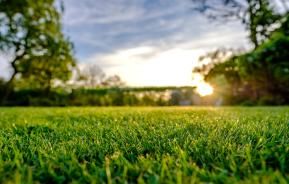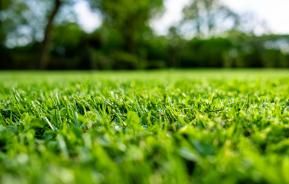When you stand in front of the fertiliser shelf at your local hardware garden centre, you will be faced with a bewildering array of lawn fertilisers of different types making all sorts of claims. Finding the fertiliser that suits you and your lawn can be daunting.
To make it easier for you, we’ve put together a simple guide to the different types of granulated or dry fertilisers for lawns.
Types of lawn fertilisers
Conventional lawn fertilisers
Traditional lawn foods are the most basic and often the cheapest. They are not, however, considered the best option for lawns.
Key features:
- Crystalline or powdered appearance
- High application rates
- Short term feeding
- Surge growth (rapid response that tails off quickly)
- Frequent applications
Traditional lawn fertilisers also tend to drop their nutrient load immediately they are watered in, which can lead to a very high rate of nutrient run-off into drains and waterways.
Basic lawn fertilisers rely on the lawn being able to absorb what it can as the nutrients flush through the soil. Frequent applications (every month to six weeks) can have detrimental effects on soil health and chemistry.
Slow release lawn fertilisers
Slow release lawn fertilisers are more advanced in their nutrient delivery they will feed lawns for up to three months.
Key features:
- Nutrients release slowly and continuously
- No nutrient dump after watering in
- Low application rate
- Three applications per year
When using a quality slow release like Scotts Lawn Builder, a consistent level of growth and greening is achieved across the life of the application with no surge growth and no nutrient run-off.
Cheap slow-release lawn fertiliser products, on the other hand, tend to initially drop a lot of nutrients and quickly taper off in their nutrient delivery, resulting in an initial greening and growth surge but consistent growth is not maintained.
Natural or organic lawn fertilisers
The use of the word ‘organic’ can be confusing when it comes to fertilisers.
A product such as traditional blood & bone fertiliser contains high levels of organic (natural) materials so can rightly be described as an organic fertiliser. However, it is more correct to consider it as an organic-based fertiliser.
A true ‘organic’ fertiliser is one that has been certified as 100% organic. The simple way to ensure that a product is organic is to look for the Australian Organic Certified logo on the pack.
Fertilisers are usually split into two main groups – organic (natural) and synthetic (manufactured). There is also a third group - a blend of the two.
When it comes to the best lawn fertilisers, Scotts Lawn Builder Plus Organics Lawn Food & Soil Improver combines the attributes of a quality slow release fertiliser with the benefits of added natural ingredients like seaweed, fish, manure and bio stimulants - the best of both worlds.
Top tip
Fertilisers that suffer from high nutrient runoff are not just bad for the environment, they are harsh on your wallet too. Wasted nutrients may as well be money down the drain!
What is lawn fertiliser NPK?
The most important thing to remember about lawn fertilisers is that you don’t need a science degree to select the right one.
Someone who does have such a degree has already done the hard work of getting the formulation right for you, with nutrients balanced for your particular needs.
It does, however, help to have an understanding of what all those letters in a fertiliser's NPK ratio mean.
N is for Nitrogen
Nitrogen is the main contributor to quality, lush, green leaf growth. This is why you’ll see most lawn fertilisers have a high N component.
P is for Phosphorus
Phosphorus is the main player in the development of flowers and fruit, so you don’t want much, if any, in lawn food. It also improves root development and disease resistance.
K is for Potassium
Potassium is the overall plant health support nutrient. It promotes growth and vigour, helps plants resist disease and keeps metabolic functions running smoothly.
S is for Sulphur
Sulphur promotes greening - it is one of the primary building blocks of chlorophyll, the pigment that gives plants their green colour. It also helps plants utilise other nutrients.
Fe is for Iron
Iron is used to keep plants green - a lack of it being absorbed by plants causes them to become yellow. Iron is not usually lacking in soils but can become chemically bound up if the soil pH is not between 5 and 6.5 (acidic).












